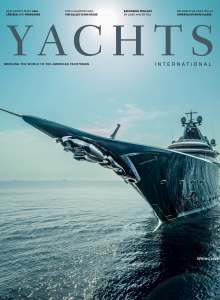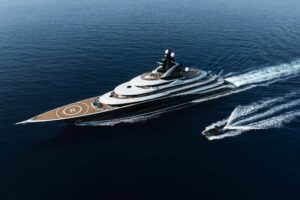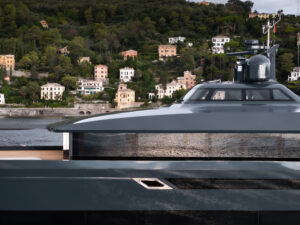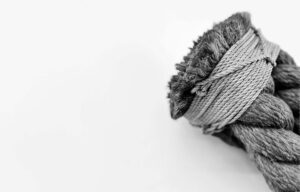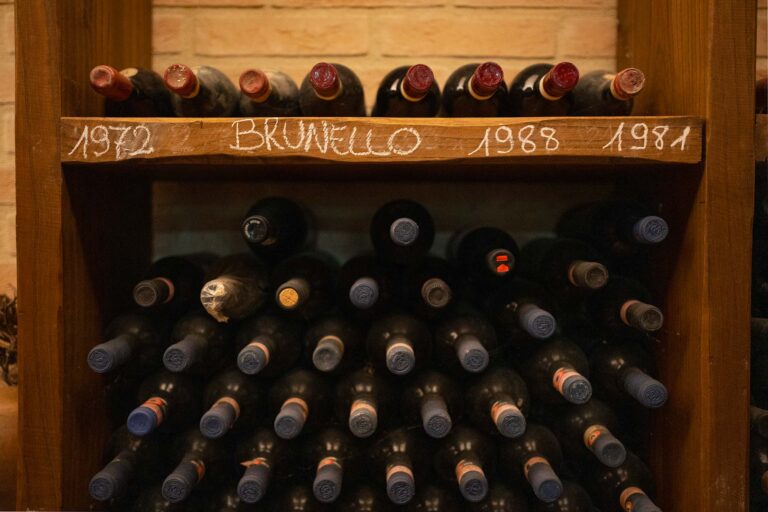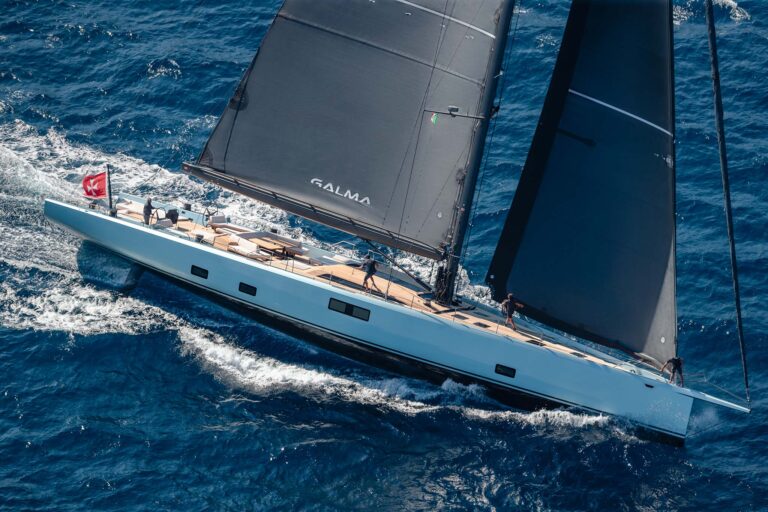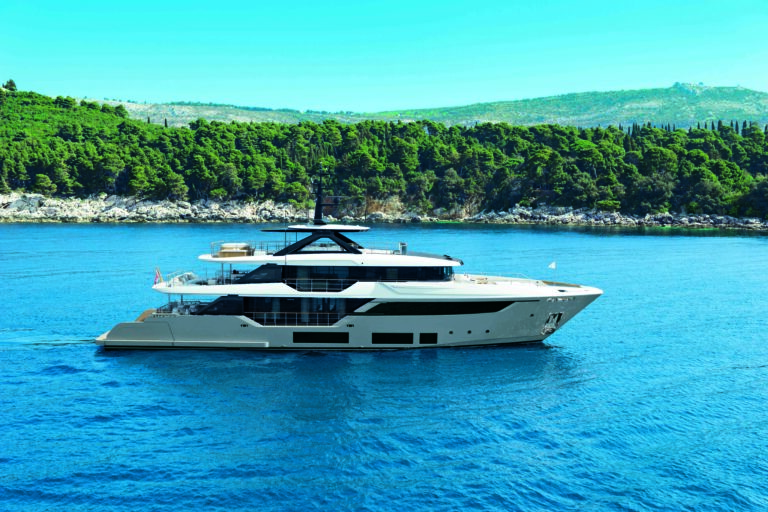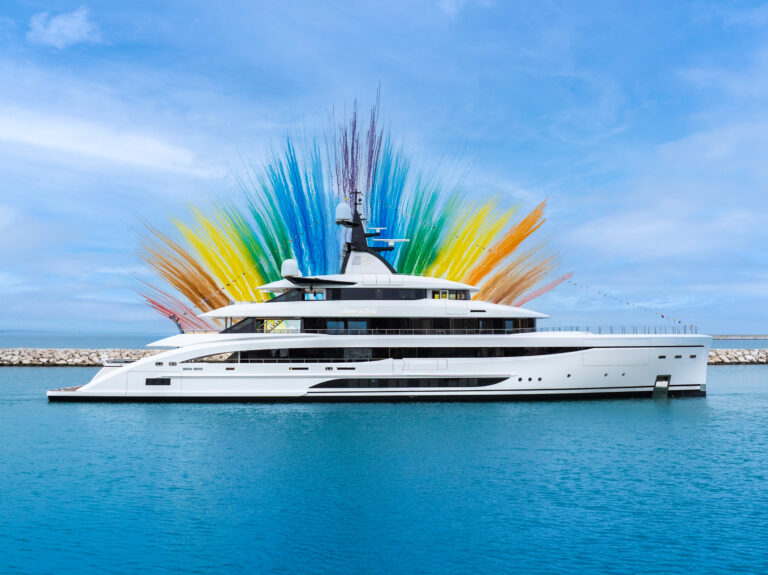2012 AIM Marine Lifetime Achievement Award Winner

The first AIM Marine Group Editor’s Choice Lifetime Achievement Award went to Annette Bénéteau-Roux, an elegant, petite woman who has steered the Beneteau Group through thick and thin since 1964. Roux came to Fort Lauderdale to accept her Lifetime Achievement Award. Microphone in hand, standing in front of a crowd of 400 happy revelers at the W Hotel, she quipped that the award had a tinge of finality she did not care for but, make no mistake about it, while she has taken a couple of steps back from everyday operations, she is still is very much involved in the company her grandfather founded. Early in November, she graciously answered our questions.
Yachts International: Beneteau is a beautiful family story. What memories, if any, do you have of your grandfather?
Annette Bénéteau-Roux: I never knew my grandfather, who died in 1928, but his memory has remained very vivid; there are so many anecdotes about him. Benjamin Bénéteau was passionate about innovation. Using his experience as a mate and naval architect, he started building fishing trawlers in 1884 in Croix-de-Vie, which is our family’s birthplace. He traveled extensively and got to know a lot of coastlines, especially in South America, which gave him the opportunity to discover all sorts of craft. It inspired him to go from the rounded shapes of the traditional canoes made in Brittany to much faster boats. He was always ahead of his time. Imagine, in 1910, he launched the first motorized sardine fishing boat.
When did he turn the business over to your father, André Bénéteau?
It’s in 1928 upon Benjamin’s death that my father, then 21, took the helm. Given his young age and his father’s strong personality, no one knew him professionally until he made a name for himself. In 1929 he launched his first sardine fishing boat, which had exceptionally elegant lines. For him, a good boat had to be a beautiful boat, and until his last day, his passion was drawing, building and personally testing the performance of his creations.

Were you often at the yard as a child?
Yes. We grew up at the shipyard and our home was in the thick of it. Family life and work life were intertwined. The boats were built in wood then, and we unknowingly took part in the birth of each boat, for instance, by going to the woods on Sunday to select an oak tree that would become the keel or rudder of the next fishing trawler. We grew up among our clients, our craftsmen, and for all of us, boatbuilding was a process that culminated with the launch, an event that the entire village attended. This was a marvelous period of my life and, writing these lines, I can still smell the scent of fresh wood and hemp. This experience solidified our bond.
When did the business go from fishing to pleasure boating, and then to composite construction? What did it change for the family business?
Traditional fishing was on the decline in the early 1960s. We were craftsmen; the shipyard had 17 full-time employees and my parents’ generation did not understand why what had always worked suddenly did not. My father’s spirits were declining and his children were not raised yet; with no new orders, we were not far from bankruptcy, which would have been a disgrace. And then this new material, known as composite, arrived from the United States. My father and his eldest son got the idea to build auxiliary boats in composite; they were small boats from 3.6 to 4.3 meters. It was 1964. I still think of these first few early boats as works of art. It is not unusual, even today, for their owners/fishermen to display them in ports along the Atlantic shore.
You were 21 when you went with your brother to the Paris Boat Show, which turned out to be a real success. What explains this success?
Confronted with the challenges the business and my family faced, I refused to stand by and watch our heritage disappear and my lifelong companions lose their livelihood after building such beautiful boats. I suddenly realized that I was going to dedicate my life to Beneteau. My decision made, I started in June 1964 and took part in a fishing show where, aside from fishermen, I met our first leisure-boat distributors, a sector in full expansion at the time. We listened to them and began modifying our boats, adding steering here, a small wooden mast there or expanding the cabin and, without realizing it, tapped into a whole new market of sport and pleasure fishing. Presented in Paris a few months later, these boats gave Beneteau its start in the leisure market. This early success allowed us to employ our craftsmen to build prototypes and to successfully convert our business without damage.
How would you explain the region of Vendée and Saint-Gilles-Croix-de-Vie (home of Beneteau) to American boat owners who have never been there?
Vendée has a very rich past. Saint-Gilles-Croix-de-Vie, a small fishing port in the middle of a region of salt marshes, was once a transportation hub—particularly for salt. It is steeped in history. Americans love history and are sensitive to authenticity. That is where we keep our corporate headquarters and I am keen on it. Not only are our roots a source of inspiration for future generations, but I believe that in a sector that thrives on passion, our heritage matters and helps our clients connect to a history that becomes theirs.
What are Beneteau’s strengths?
What makes a company successful is not one thing, it’s the whole, plus the ability to adapt to market fluctuations. We were all artisans before the development of our sector forced many of us to become more industrialized. Not everyone was able to adapt; it resulted in the concentration of the business in a few hands. When the economy is doing well, you have to be able to produce in series and organize your business accordingly. Then, when the market contracts, you have to adapt again. Aside from having the know-how, you have to be very solid to survive in this business.

How did such a quintessentially French company—you even worked with Philippe Starck—succeed in creating an international empire?
Often people talk to me about having been successful. Since a company is not finite, you can never say you have been successful; each day brings a new set of options, and it takes a while to know if you’ve made the right decisions.
Our strategy was first to consolidate our foundation and then to grow organically, which did not exclude strategic acquisitions. But there is a time for everything, and I don’t like to confuse speed and hastiness.
Aside from bringing outside talents such as Philippe Starck—an idea that was quite new particularly in the sailing sector in the 1980s—I am particularly proud to have had the foresight to build a factory in Marion, SC, in 1986. Few French people succeeded in the United States and the financial world did not give us much of a chance, but we did make it and we began to understand the American market. It helped make our brand more international. Since then, aside from acquiring brands that have integrated well in our group, in 2008 we opened a rep office in Shanghai and in May 2012 rolled our first boats out of our Brazilian factory.
How did you anticipate market demands?
You can never say that you have perfectly anticipated market demands. You know, competition in this business is the same as elsewhere, the one who makes the least amount of errors wins. We also listen to our teams on-site; the best strategists are our clients, and you need to hear them and interpret correctly what they are trying to achieve.
Did becoming a public company listed on the stock exchange change the company culture?
Entering the stock market in 1984 allowed us to start our production unit in the United States. Even if it has constraints, it has not changed our company’s culture. However, in times of economic flux, people who do not fully understand how the market works can make assumptions that stock prices directly reflect on the health of the company, which is not always the case. It can create needless internal stress.

The group has grown with the acquisition of brands, but the marketing strategy seems to be to keep each brand separate. Why is this?
Our brands must remain independent, have their own identity and even compete to an extent. This is the choice we made when we joined with Jeanneau in 1995, and we are very happy with that decision. Our brands have the same “mother,” but their creative and commercial independence creates a healthy environment for emulation.
How and where do you see the future of leisure boating?
I am not worried about the future of our business, even if our sector currently suffers greatly from the consequences of the economic recession. This time reminds me of the 1990s. That spectacular drop in business was followed by a decade of growth that we had trouble managing. This said, the world is undergoing a major transition and there will be markets, but not necessarily where they are today. It is a difficult period. However, the challenges it presents are extremely interesting.
What is your role today at Bénéteau?
Each step in life requires one to adapt. In 2004, I instituted a new type of corporate governance, which allowed me to step back a bit without feeling guilty. It does not mean that I lost interest in the group or our business. My family is very much attached to the company and retains nearly 60 percent of the capital.
Ours is not an easy business; it requires know-how, which the young generations must be willing to receive from their elders with respect and humility. It’s a difficult step for an entrepreneur to learn how to fade into the background and yet stay sufficiently aware so as to make the right decisions when presented with options.
There is a debate in leisure boating between sail or motor. Which camp do you belong to?
There should not be any debate. A boat is simply a means of pleasure. We have many clients who have a sailboat for cruising and a motorboat for fishing, for instance. Traditionally, sailing is more popular in Europe and motor boating is more popular in the United States. It is likely that the two markets will subsist, but the motor sector will remain far bigger, in my opinion.
Interview Cecile Gauert – Translated from French

